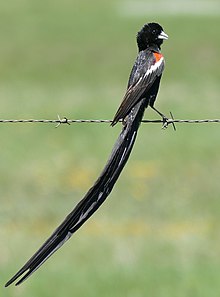| Long-tailed widowbird | |
|---|---|

| |
| Breeding male perched on a fence at Wakkerstroom, South Africa | |
| Scientific classification | |
| Domain: | Eukaryota |
| Kingdom: | Animalia |
| Phylum: | Chordata |
| Class: | Aves |
| Order: | Passeriformes |
| Family: | Ploceidae |
| Genus: | Euplectes |
| Species: | E. progne
|
| Binomial name | |
| Euplectes progne (Boddaert, 1783)
| |

| |
resident range
| |
The long-tailed widowbird (Euplectes progne) is a species of bird in the family Ploceidae.[2] The species are found in Angola, Botswana, the Democratic Republic of the Congo, Kenya, Lesotho, South Africa, Eswatini, and Zambia.[3] The long-tailed widowbird is a medium-sized bird and one of the most common in the territories it inhabits.[4] Adult breeding males are almost entirely black with orange and white shoulders (epaulets), long, wide tails, and a bluish white bill.[2] Females are rather inconspicuous, their feathers streaked tawny and black with pale patches on the chest, breast and back, narrow tail feathers, and horn-colored bills.[2]
When flying, male long-tailed widowbirds are readily visible due to their extremely long tails. Between six and eight of their twelve tail feathers are approximately half a metre (approximately 20 inches) long. The tail during flight display is expanded vertically into a deep, long keel below the male as he flies with slow wingbeats 0.5 to 2 metres (20 to 78 inches) above his territory.
Because of the seemingly large cost to such male ornaments, the long-tailed widowbird has been the subject of extensive research into the function and evolution of sexually selected traits.[5] This research has demonstrated the existence of female choice in sexual selection and indicates the trade-offs between sexual appeal and physical constraints with regard to the evolution of sexual ornaments.[6]
- ^ BirdLife International (2016). "Euplectes progne". IUCN Red List of Threatened Species. 2016: e.T22719244A94619254. doi:10.2305/IUCN.UK.2016-3.RLTS.T22719244A94619254.en. Retrieved 11 November 2021.
- ^ a b c Mackworth-Praed, C.W., and C.H. Grant. (1960). Birds of Eastern and North Eastern Africa. Longmans, Green and Co LTD.; London
- ^ Hall, B. P. and R. E. Moreau. (1970). An atlas of speciation in African passerine birds. British Museum of Natural History, London.
- ^ Andersson, M. (1982). "Female choice selects for extreme tail length in a widowbird." Nature, 299: 818–820.
- ^ Cite error: The named reference
Davieswas invoked but never defined (see the help page). - ^ Cite error: The named reference
Maltewas invoked but never defined (see the help page).

